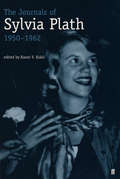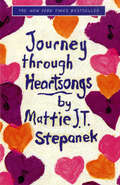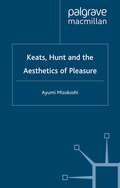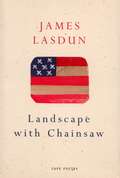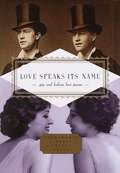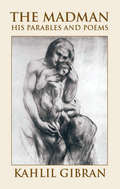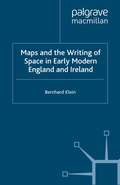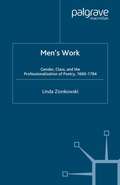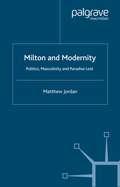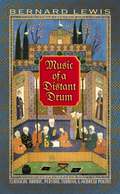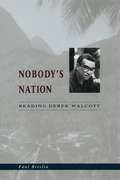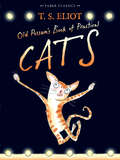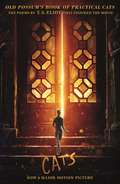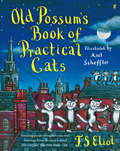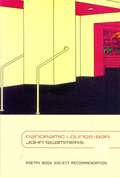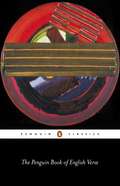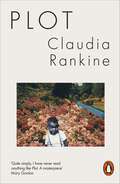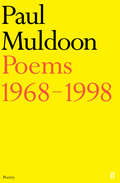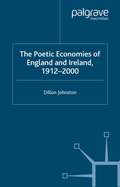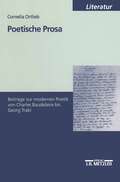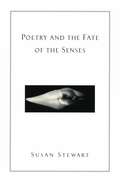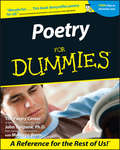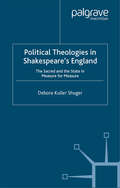- Table View
- List View
The Journals of Sylvia Plath: Transcribed From The Original Manuscripts At Smith College
by Sylvia PlathThe Journals of Sylvia Plath offers an intimate portrait of the author of the extraordinary poems for which Plath is so widely loved, but it is also characterized by a prose of vigorous immediacy which places it alongside The Bell Jar as a work of literature. These exact and complete transcriptions of the journals kept by Plath for the last twelve years of her life - covering her marriage to Ted Hughes and her struggle with depression - are a key source for the poems which make up her collections Ariel and The Colossus.'Everything that passes before her eyes travels down from brain to pen with shattering clarity - 1950s New England, pre-co-ed Cambridge, pre-mass tourism Benidorm, where she and Hughes honeymooned, the birth of her son Nicholas in Devon in 1962. These and other passages are so graphic that you look up from the page surprised to find yourself back in the here and now . . . The struggle of self with self makes the Journals compelling and unique.' John Carey, Sunday Times
Journey Through Heartsongs (Americana Ser.)
by Mattie J.T. StepanekMattie J. T. Stepanek takes us on a Journey Through Heartsongs with more of his moving poems. These poems share the rare wisdom that Mattie has acquired through his struggle with a rare form of muscular dystrophy and the death of his three siblings from the same disease. His life view was one of love and generosity and as a poet and a peacemaker, his desire was to bring his message of peace to as many people as possible.
Keats, Hunt and the Aesthetics of Pleasure (Romanticism in Perspective:Texts, Cultures, Histories)
by Ayumi MizukoshiThis book tackles the age-old interpretative problem of 'pleasure' in Keat's poetry by placing him in the context of the liberal, leisured and luxurious culture of Hunt's circle. Challenging the standard narrative which attribute Keat's astonishing poetic development to his separation from Hunt, the author cogently argues that Keats, profoundly imbued with Hunt's bourgeois ethic and aesthetic, remained a poet of sensuous pleasure through to the end of his short career.
Landscape With Chainsaw: Poems (Cape Poetry Ser.)
by James LasdunJames Lasdun's third book of poems explores the themes and tensions of his last two with a new boldness and exuberance, in a series of poems about life in the Catskill mountains outside Woodstock, where the author moved with his family some years ago. Questions of exile and belonging, cutting ties and forming new bonds, figure prominently, as does the struggle to find a viable relationship with the natural world of the mountain wilderness - at once a stunning companion and a ferocious competitor. Out of this - 'the need to carve out a niche for ourselves;/our singular relation to what we love' - rises the book's central image: the chainsaw. Very much a real machine (given to the alarmed poet by his wife), it also comes to form a complex symbol in which all manner of human traits are reflected with an intense, often comical, brilliance.A brilliantly assured, deftly lyrical sequence, Landscape with Chainsaw melds passion with wit, the classical with the quotidian, in a thrilling meditation on history, love, cultural identity and the anxiety of displacement. As an examination of the complexities of deracination and domesticity, it marks the matured genius of one of England's most important poets.
Love Speaks Its Name: Gay And Lesbian Love Poems (Everyman's Library Pocket Poets)
by J. D. McClatchyFrom Sappho to Shakespeare to Cole Porter-a marvelous and wide-ranging collection of classic gay and lesbian love poetry. The poets represented here include Walt Whitman, Hart Crane, Gertrude Stein, Federico Garcìa Lorca, Djuna Barnes, Constantine Cavafy, Elizabeth Bishop, W. H. Auden, and James Merrill. Their poems of love are among the most perceptive, the most passionate, the wittiest, and the most moving we have. From Michelangelo's "Love Misinterpreted" to Noël Coward's "Mad About the Boy," from May Swenson's "Symmetrical Companion" to Muriel Rukeyser's "Looking at Each Other," these poems take on both desire and its higher power: love in all its tender or taunting variety.
The Madman: His Parables and Poems
by Kahlil GibranWidely known in America as author of The Prophet, which sold more copies in the 20th century than any other book but the Bible, the great Lebanese-American poet and artist Kahlil Gibran (1883–1931) first became known to Americans in 1918 with the publication of The Madman.Thought-provoking and inspiring, the book is a collection of memorable, life-affirming parables and poems, many of them casting an ironic light on the beliefs, aspirations, and vanities of humankind — and many reminiscent of the work of Tagore and Nietzsche, both of whom were strong influences on Gibran.Among the 35 poems and parables in this volume are "How I Became a Madman," "The Two Hermits," "The Wise Dog," "The Good God and the Evil God," "Night and the Madman," "The Three Ants," "When My Sorrow Was Born," "And When My Joy Was Born," and many more.The book includes several illustrations by the author, whose exquisite drawings are reminiscent of Rodin and the best of Blake. ". . . the greatest of Arab Romantics and father of a 20th-century Romantic tradition whose impact on Arab writers has been at least as strong as that of 19th-century figures such as Wordsworth and Keats on their English-speaking counterparts." — Dr. Suheil Bushrui, Director of the Kahlil Gibran Chair on Values and Peace, University of Maryland
Maps and the Writing of Space in Early Modern England and Ireland
by B. KleinMaps make the world visible, but they also obscure, distort, idealize. This wide-ranging study traces the impact of cartography on the changing cultural meanings of space, offering a fresh analysis of the mental and material mapping of early modern England and Ireland. Combining cartographic history with critical cultural studies and literary analysis, it examines the construction of social and political space in maps, in cosmography and geography, in historical and political writing, and in the literary works of Marlowe, Shakespeare, Spenser and Drayton.
Men’s Work: Gender, Class, and the Professionalization of Poetry, 1660–1784
by L. ZionkowskiThis book examines how the concept of the poet as a male professional emerged during the Restoration and eighteenth century. Analyzing works by writers from Rochester to Johnson, Linda Zionkowski argues that the opportunities for publication created by the growth of a commercial market in texts profoundly challenged aristocratic conceptions of authorship and altered the status of professional poets on the hierarchies of class and gender. The book proposes that during this period, discourse about the poet's social role both revealed and produced a crucial shift in configurations of masculinity: the belief that commodifying their mental labor undermined writers' cultural authority gave way to a celebration of the market's function as the proving ground for both literary merit and bourgeois manhood.
Milton and Modernity: Politics, Masculinity and Paradise Lost
by M. JordanThis book presents a theoretical and historicized reading of the production of the 'autonomous' subject in Milton's prose and in Paradise Lost. It rejects the current orthodoxy that liberal humanism is just a form of domination, and reads Milton's texts as revolutionary. Although Milton participates in the formation of discourses of sexuality, labour and the nature of reason which come to be normative, neither Milton's texts nor modernity more generally can be understood without also accepting the dynamism inherent in the belief in individual freedom.
Music of a Distant Drum: Classical Arabic, Persian, Turkish, and Hebrew Poems
by Bernard LewisMusic of a Distant Drum marks a literary milestone. It collects 129 poems from the four leading literary traditions of the Middle East, all masterfully translated into English by Bernard Lewis, many for the first time. These poems come from diverse languages and traditions--Arabic, Persian, Turkish, and Hebrew--and span more than a thousand years. Together they provide a fascinating and unusual window into Middle Eastern history. Lewis, one of the world's greatest authorities on the region's culture and history, reveals verses of startling beauty, ranging from panegyric and satire to religious poetry and lyrics about wine, women, and love. Bernard Lewis, one of the world's greatest authorities on the region's culture and history, offers a work of startling beauty that leaves no doubt as to why such poets were courted by kings in their day. Like those in the Rubaiyat of Omar Khayyam, the poems here--as ensured by Lewis's mastery of all the source languages and his impeccable style and taste--come fully alive in English. They are surprising and sensuous, disarmingly witty and frank. They provide a fascinating and unusual glimpse into Middle Eastern history. Above all, they are a pleasure to read.They range from panegyric and satire to religious poetry and lyrics about wine, women, and love. Lewis begins with an introduction on the place of poets and poetry in Middle Eastern history and concludes with biographical notes on all the poets.This treasure trove of verse is aptly summed up by a quote from the ninth-century Arab author Ibn Qutayba: "Poetry is the mine of knowledge of the Arabs, the book of their wisdom, the muster roll of their history, the repository of their great days, the rampart protecting their heritage, the trench defending their glories, the truthful witness on the day of dispute, the final proof at the time of argument.?In one hand the Qur'vn, in the other a wineglass,Sometimes keeping the rules, sometimes breaking them.Here we are in this world, unripe and raw,Not outright heathens, not quite Muslims.--Mujir (12th century)
Nobody's Nation: Reading Derek Walcott
by Paul BreslinNobody's Nation offers an illuminating look at the St. Lucian, Nobel-Prize-winning writer, Derek Walcott, and grounds his work firmly in the context of West Indian history. Paul Breslin argues that Walcott's poems and plays are bound up with an effort to re-imagine West Indian society since its emergence from colonial rule, its ill-fated attempt at political unity, and its subsequent dispersal into tiny nation-states. According to Breslin, Walcott's work is centrally concerned with the West Indies' imputed absence from history and lack of cohesive national identity or cultural tradition. Walcott sees this lack not as impoverishment but as an open space for creation. In his poems and plays, West Indian history becomes a realm of necessity, something to be confronted, contested, and remade through literature. What is most vexed and inspired in Walcott's work can be traced to this quixotic struggle. Linking extensive archival research and new interviews with Walcott himself to detailed critical readings of major works, Nobody's Nation will take its place as the definitive study of the poet.
Nobody's Nation: Reading Derek Walcott
by Paul BreslinNobody's Nation offers an illuminating look at the St. Lucian, Nobel-Prize-winning writer, Derek Walcott, and grounds his work firmly in the context of West Indian history. Paul Breslin argues that Walcott's poems and plays are bound up with an effort to re-imagine West Indian society since its emergence from colonial rule, its ill-fated attempt at political unity, and its subsequent dispersal into tiny nation-states. According to Breslin, Walcott's work is centrally concerned with the West Indies' imputed absence from history and lack of cohesive national identity or cultural tradition. Walcott sees this lack not as impoverishment but as an open space for creation. In his poems and plays, West Indian history becomes a realm of necessity, something to be confronted, contested, and remade through literature. What is most vexed and inspired in Walcott's work can be traced to this quixotic struggle. Linking extensive archival research and new interviews with Walcott himself to detailed critical readings of major works, Nobody's Nation will take its place as the definitive study of the poet.
Nobody's Nation: Reading Derek Walcott
by Paul BreslinNobody's Nation offers an illuminating look at the St. Lucian, Nobel-Prize-winning writer, Derek Walcott, and grounds his work firmly in the context of West Indian history. Paul Breslin argues that Walcott's poems and plays are bound up with an effort to re-imagine West Indian society since its emergence from colonial rule, its ill-fated attempt at political unity, and its subsequent dispersal into tiny nation-states. According to Breslin, Walcott's work is centrally concerned with the West Indies' imputed absence from history and lack of cohesive national identity or cultural tradition. Walcott sees this lack not as impoverishment but as an open space for creation. In his poems and plays, West Indian history becomes a realm of necessity, something to be confronted, contested, and remade through literature. What is most vexed and inspired in Walcott's work can be traced to this quixotic struggle. Linking extensive archival research and new interviews with Walcott himself to detailed critical readings of major works, Nobody's Nation will take its place as the definitive study of the poet.
Old Possum's Book of Practical Cats: with illustrations by Rebecca Ashdown (Faber Children's Classics Ser. #13)
by T. S. Eliot'The cat himself knows and will never confess...'To celebrate Old Possum's 75th anniversary we have commissioned lively new illustrations from Rebecca Ashdown for T.S. Eliot's original book of Practical Cats. Featuring Macavity, the Mystery Cat; Mr Mistofelees, the Original Conjuring Cat; Mungojerrie and Rumpelteazer and all the gang, this is a must for every child's bookshelf and is a great companion to the Andrew Lloyd Webber stage show.
Old Possum's Book of Practical CATS: Cats Movie Tie-in (Faber Children's Classics Ser. #13)
by T. S. EliotCats! Some are sane, some are mad and some are good and some are bad.Meet magical Mr Mistoffelees, sleepy Old Deuteronomy and curious Rum Tum Tugger. But you'll be lucky to meet Macavity because Macavity's not there!In 1925 T.S. Eliot became co-director of Faber & Faber, who remain his publishers to this day. Throughout the 1930s he composed the now famous poems about Macavity, Old Deuteronomy, Mr Mistoffelees and many other cats, under the name of 'Old Possum'. In 1981 Eliot's poems were set to music by Andrew Lloyd Webber as Cats, which went on to become the longest-running Broadway musical in history and is now a film starring Taylor Swfit, Idris Elba, Judi Dench, Ian McKellen, Rebel Wilson, Jennifer Hudson, Jason Derulo, Francesca Hayward and James Corden. With illustrations by Rebecca Bagley.
Old Possum's Book of Practical Cats: Cats Movie Tie-in (Faber Children's Classics Ser. #13)
by T. S. EliotA stunning new edition of T. S. Eliot's beloved cat poems Old Possum's Book of Practical Cats, containing beautiful original colour illustrations by Axel Scheffler.Cats! Some are sane, some are mad and some are good and some are bad.Meet magical Mr Mistoffelees, sleepy Old Deuteronomy and curious Rum Tum Tugger. But you'll be lucky to meet Macavity because Macavity's not there!In 1925 T.S. Eliot became co-director of Faber & Faber, who remain his publishers to this day. Throughout the 1930s he composed the now famous poems about Macavity, Old Deuteronomy, Mr Mistoffelees and many other cats, under the name of 'Old Possum'. In 1981 Eliot's poems were set to music by Andrew Lloyd Webber as Cats which went on to become the longest-running Broadway musical in history. 'If cats, witchy or not, are your child's thing don't miss the new Old Possum's Book of Practical Cats.' The Times'A lovely edition of an old favourite . . . it will be enjoyed again and again.' Carousel'Classic cat poems . . . are given a delightful new look.' LoveReading4Kids
Panoramic Lounge Bar
by John StammersJohn Stammers's collection is witty, touching and clever - with brilliant images where love scenes are laced with irony and the details of contemporary life. He writes about irrelevant vampires living out their days on the sea front at Eastbourne; about flowers with 'fine pointed petals like scalpels' and is absolutely brilliant on music. His writing is vivid and assured.
The Penguin Book of English Verse
by P J KeeganThis ambitious and revelatory collection turns the traditional chronology of anthologies on its head, listing poems according to their first individual appearance in the language rather than by poet.
Plot (Grove Press Poetry Ser.)
by Claudia RankineThe stunningly original exploration of pregnancy and childbirth by the acclaimed author of CitizenIn this, the landmark achievement that crowned the first phase of her writing career, Claudia Rankine invites us into the lives of Liv and her husband Erland, as they find themselves propelled into the classic plot: boy loves girl, girl gets pregnant. The couple's journey is charted through dreams, conversations and reflections, in a text like no other, deftly moulding language and crossing genres to arrive at new life: baby Ersatz.Plot is an inventive and engrossing meditation on pregnancy and the changes it heralds: the potential bodily cost, the loss of self, the sense of impending stasis. Each fear compounds Liv's reluctance to bring new life into a bewildering world. A profoundly daring collection, it explodes the emotive capabilities of language and form to achieve an unparalleled understanding of creation and existence.
Poems 1968-1998
by Paul Muldoon'Thirty years of work from "the most significant English-language poet born since the second world war.'The Times Literary Supplement
The Poetic Economists of England and Ireland 1912-2000
by D. JohnstonAlthough modern English and Irish poetry arises from the different cultures of the two countries these poets have shared - throughout this century - the same editors and publishers, competed for the same prizes, and been judged, ostensibly, by the same standards. This book examines contexts for these exchanges over four decades - tracing the lineages of Yeats and Hardy from their meeting in 1912 through WWI, the 30s, the 60s, and the 90s, - to see what influences and ideas are exchanged and how poetic value accrues.
Poetische Prosa: Beiträge zur modernen Poetik von Charles Baudelaire bis Georg Trakl
by Cornelia OrtliebCharles Baudelaire initiierte mit seinen Prosagedichten eine eigene Gattung Literatur, die zu einem Paradigma der Moderne wurde und sich in keinen überlieferten Literaturkanon fügen lässt. Eine Gattung, die von höchster stilistischer Varietät ist: De Quinceys Variationen in Prosa gehören ihr an, die rhetorische Emphase Nietzsches, doch ebenso die enigmatische Bildlichkeit Mallarmés und Trakls. Die Prosa erhebt denselben Anspruch auf stilistische Höhe wie vordem die Lyrik, dennoch schreibt die Gattungstheorie den strikten Gegensatz von »Poesie« und »Prosa« fort: das Prosagedicht als Mischform und Grenzfall der Theorie stellt also das System der Klassifikation poetischer Texte gleich mehrfach in Frage. Die kritische Lektüre und die Diskussion ihrer Verfahren nach Kategorien wie Rhythmus, Stil, Figur und Inszenierung zeigt die paradigmatischen Merkmale moderner Prosadichtung in der Überwindung der Aporien der Gattungstheorie auf.
Poetry and the Fate of the Senses (Phoenix Poets Ser.)
by Susan StewartWhat is the role of the senses in the creation and reception of poetry? How does poetry carry on the long tradition of making experience and suffering understood by others? With Poetry and the Fate of the Senses, Susan Stewart traces the path of the aesthetic in search of an explanation for the role of poetry in our culture. The task of poetry, she tells us, is to counter the loneliness of the mind, or to help it glean, out of the darkness of solitude, the outline of others. Poetry, she contends, makes tangible, visible, and audible the contours of our shared humanity. It sustains and transforms the threshold between individual and social existence. Herself an acclaimed poet, Stewart not only brings the intelligence of a critic to the question of poetry, but the insight of a practitioner as well. Her new study draws on reading from the ancient Greeks to the postmoderns to explain how poetry creates meanings between persons. Poetry and the Fate of the Senses includes close discussions of poems by Stevens, Hopkins, Keats, Hardy, Bishop, and Traherne, of the sense of vertigo in Baroque and Romantic works, and of the rich tradition of nocturnes in visual, musical, and verbal art. Ultimately, Stewart explores the pivotal role of poetry in contemporary culture. She argues that poetry can counter the denigration of the senses and can expand our imagination of the range of human expression. Poetry and the Fate of the Senses won the 2004 Truman Capote Award for Literary Criticism in Memory of Newton Arvin, administered for the Truman Capote Estate by the University of Iowa Writers' Workshop. It also won the Phi Beta Kappa Society's 2002 Christian Gauss Award for Literary Criticism.
Poetry For Dummies (For Dummies Ser.)
by The Poetry Center John TimpaneSometimes it seems like there are as many definitions of poetry asthere are poems. Coleridge defined poetry as "the best wordsin the best order." St. Augustine called it "theDevil's wine." For Shelley, poetry was "therecord of the best and happiest moments of the happiest and bestminds." But no matter how you define it, poetry has exerciseda hold upon the hearts and minds of people for more than fivemillennia. That's because for the attentive reader, poetryhas the power to send chills shooting down the spine and lightningbolts flashing in the brain - to throw open thedoors of perception and hone our sensibilities to a scalpel'sedge. Poetry For Dummies is a great guide to reading andwriting poems, not only for beginners, but for anyone interested inverse. From Homer to Basho, Chaucer to Rumi, Shelley toGinsberg, it introduces you to poetry's greatestpractitioners. It arms you with the tools you need to understandand appreciate poetry in all its forms, and to explore your owntalent as a poet. Discover how to: Understand poetic language and forms Interpret poems Get a handle on poetry through the ages Find poetry readings near you Write your own poems Shop your work around to publishers Don't know the difference between an iamb and a trochee?Worry not, this friendly guide demystifies the jargon, and itcovers a lot more ground besides, including: Understanding subject, tone, narrative; and poeticlanguage Mastering the three steps to interpretation Facing the challenges of older poetry Exploring 5,000 years of verse, from Mesopotamia to the globalvillage Writing open-form poetry Working with traditional forms of verse Writing exercises for aspiring poets Getting published From Sappho to Clark Coolidge, and just about everyone inbetween, Poetry For Dummies puts you in touch with thegreats of modern and ancient poetry. Need guidance on composing aghazal, a tanka, a sestina, or a psalm? This is the book foryou.
Political Theologies in Shakespeare's England: The Sacred and the State in Measure for Measure
by Debora ShugerShuger's study of Measure to Measure offers a sweeping reinterpretation of English political thought in the aftermath of the Reformation, one that focuses not on the tension between Crown and Parliament but on the relation of the sacred to the state.
